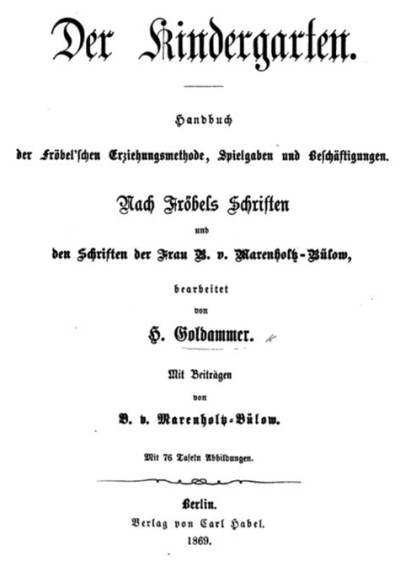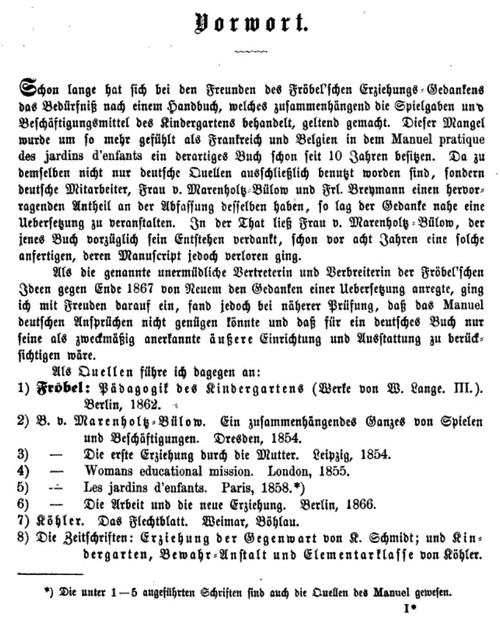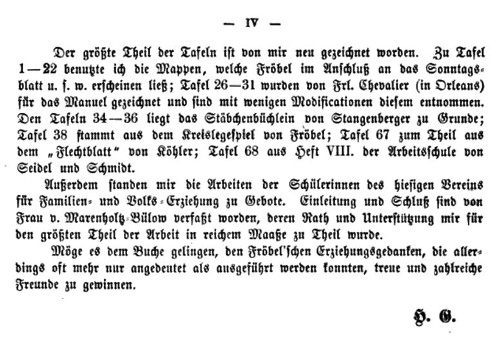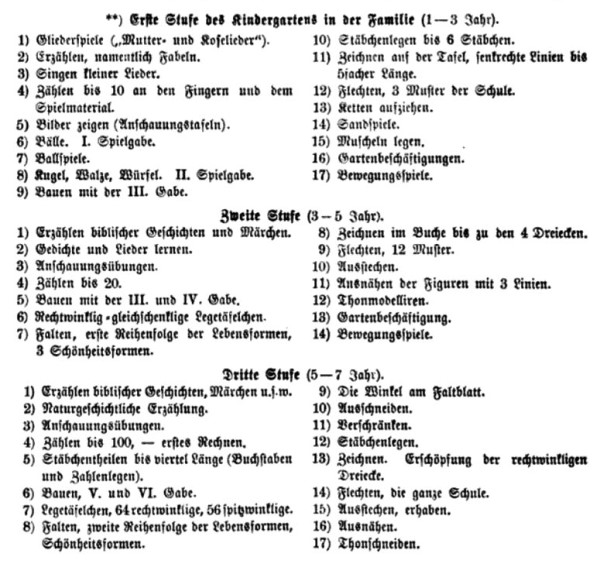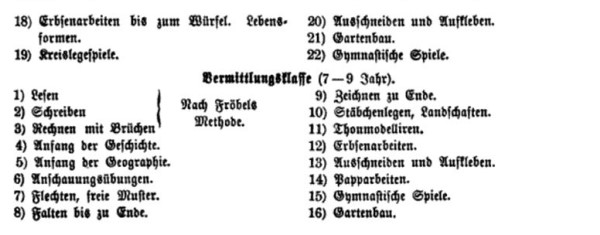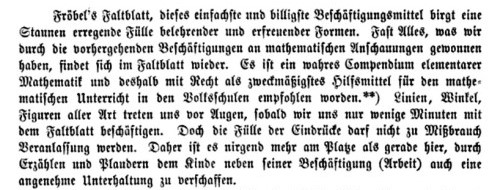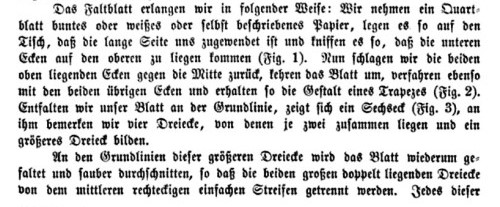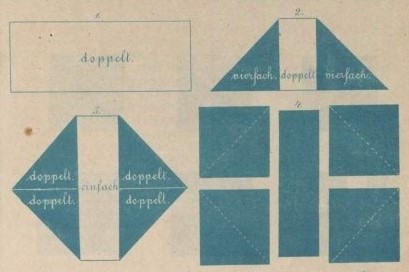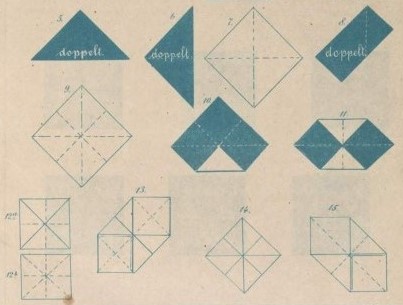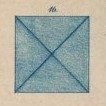| The Public Paperfolding History Project
Last updated 29/9/2025 x |
|||||||
| Der Kindergarten by Hermann Goldammer , 1869 | |||||||
| 'Der
Kindergarten', edited by Hermann Goldammer was published
by Habel in Berlin in 1869. Inter alia, it contains
chapters on Das Falten, Ausschneiden und Aufkleben (as
Ausflechen und Ausnahen), Das Flechten and Das
Verschnuren. A full copy of the work can be accessed online here. ********** Authorship According to 'The Life of the Baroness Marenholz-Bulow' (available online here) this work was 'a translation, with some additions' of 'Manuel pratique des jardins d'enfants de Frédéric Froebel' by J F Jacobs, which was published by F Claassen in Brussells and L Hachette and Cie in Paris in 1859. A second edition was published in 1872 and can be accessed online here. The paperfolding material in this second edition appears to me to be identical to the material in the first edition. A third 'revised and enlarged' edition was published in 1874. A translation of the first edition into English appeared in 1869, the same year as the original work was published, as 'Paradise of Childhood' by Edward Wiebe. A translation of Book 1 of the 1874 third edition into French by Louis Fournier was published in 1877 as 'Le jardins d'enfants, dons et occupations'. **********
********** In the Foreword the author explains the origin of the work, quotes his sources and explains the origin of the Plates. The first paragraph reads, roughly translated: 'For a long time the friends of Froebel's educational philosophy have felt the need for a handbook addressing the gifts and occupations of the kindergarten. This lack was felt all the more since France and Belgium had already published such a book, the Manuel pratique des jardins d'enfants, ten years ago. Since not only were the sources exclusively German, but German collaborators, Frau von Marenholtz-Bulow and Frau Breymann, also played a prominent role in its composition, the idea of undertaking a translation was a natural one. In fact Frau von Marenholtz-Bulow, to whom this book owes its existence, commissioned one eight years ago, but the manuscript was lost.'
********** The Introduction contains a table which divides kindergarten into 4 stages and gives a summary of the use of the gifts and occupations in each. The four stages are: Stage 1: Ages 1 to 3 years - kindergarten in the family (no paperfolding) Stage 2: Ages 3 to 5 years (7, Falten: first sequence of Folds of Life / 3 Folds of Beauty. Stage 3: Ages 5 to 7 years (8, Falten: second sequence of Folds of Life / Folds of Beauty) Stage 4: Ages 7 to 9 Transition class (8. Falten: to the end. 13. Ausschneiden und Aufklaben. 14. Papparbeiten ie Cardboard Modelling.) Note that there is no other mention of Papparbeiten in the work.
********** Analysis Das Falten The chapter starts with a eulogy for paperfolding:
********** Froebel's method of cutting four squares from a rectangle Note that the central strip is used for Verschnuren.
********** Geometrical Paperfolds The text describes a number of simple geometrical paperfolds which can be used to teach mathematical concepts and which lead to the form shown in picture 16 which the text says 'is the basic shape for a simple series of Folds of Life'. The instructions for making this form are not perfectly clear to me, but if picture 12a is the blintzed square and picture 14 the Double Blintz Basic Form, picture 16 is presumably the Triple Blintzed Basic Form, which is odd in the context of the list of Folds of Life given below.
********** Lebensformen - Folds of Life The author gives a brief list of Folds of Life There are no illustrations to help identify them and the author states that 'It is impossible to give an exact description of the manner in which they are folded'.
Here is my attempt to identify the designs listed: Ein tischtuch (a tablecloth) - probably The Tablecloth Ein Vogel (a bird) - probably the Cocotte / Pajarita Ein Seegelboot (a sail-boat) - probably the Boat with Sail Einen Doppelkahn (a double canoe) - probably the Double Boat Ein Salznapfchen (a salt cellar) - probably the Salt Cellar Ein Blume (a flower) - probably the Flat Flower Ein Hemdchen (a chemise) - probably the Collar Einen Drachen (a dragon) - not identifiable Ein Windmuhle (a windmill) - probably The Windmill Einen Tisch (a table) - probably The Table Eine Cigarrentashe (a cigar-holder) - probably The Cigar Case Einen Blumentopf (a flower-pot) - probably the Vase Einen Doppelkasten (a double box) - probably the Double Fishbox / The Portfolio Einen Grossen Kasten ( a big box) - probably the Large Box Ein Boot (a boat) - probably the Gondola Ein Boot mit Banken (a boat with seats) - this may possibly be a reference to the Chinese Junk which is also included in the second list. There is also a second list of forms, also lacking illustrations, which the author says are mentioned in the manual. The manual in question is, however, not identified. Den Strickbeutel (the knitting-pouch) - probably the Puzzle Purse. (The translation 'knitting-pouch' comes from Edward Wiebe's 'Paradise of Childhood', also published in 1869 and which is closely based on this book. The 1874 edition of 'Der Kindergarten' contains an illustration of den Strickbeutel which seems to be the Puzzle Purse.) Den Cylinder (the top hat) - probably the Hat / Shirt Die Stiefel (the boots) - probably the Pair of Boots Den Hut (the cap) - not identifiable, although possibly the Hat / Shirt turned upside down. Das Kreuz (the cross) - probably The Cross Die Beinkleider (the trousers) - probably The Trousers Das Geschlossene Kasten (the closed box) - not identifiable Den Rahmen (the frame) - probably The Picture Frame Die Gondel (the gondola) - probably The Chinese Junk ********** Schonheitsformen - Folds of Beauty The author states that the simple basic form for the life forms is also the base for the Folds of Beauty. Plate C shows designs developed frone one side of the Double Blintz Basic Form. The shading is not used to differentiate the two sides of the paper but sections of the designs whichever side they are formed from.
********** If Picture 16 on Plate B is the Triple Blintz Basic Form then picture 17 is presumably the doubly blintzed square, from which the internal flaps are pulled out to create the Windmill. Forms 18 to 21 are created from the Windmill. Forms 22 to 27 from the Windmill Base. The shading is not used to differentiate the two sides of the paper but sections of the designs whichever side they are formed from.
********** Picture 18 shows the result of folding the flaps of the Windmill form inwards.
********** Picture 19 is obtained by folding the front flaps in half.
********** Picture 20 is obtained by then opening out and squashing the front layers.
********** Picture 21 is obtained by folding the new front layer in half. If the reverse of the paper is a different colour a genuine colour-change will be obtained here.
********** Picture 22 shows Four Points
********** Picture 23 shows Four Kites
********** I am not sure how the pattern shown in picture 25 is intended to be obtained.
********** Picture 27 shows a version of Four Points in which the flaps have been folded forwards instead of backwards
********** I am not sure how the pattern shown in Picture 26 is intended to be obtained.
********** Verschnuren Plates A and B show some examples of designs that can be made by folding and interlacing paper strips.
********** Flechten - Free Weaving Plate F shows some examples of patterns and shapes that can be woven from doubled strips
********** The Woven Cross
********** Ausschneiden und Aufkleben (Cutting out and Mounting) Ausschneiden Plates A, B and C show a variety of ways in which to cut a square folded into an eight-layered right angle isosceles triangle to create patterns with eight-fold symmetry. Ausschneiden Plates D and E show a variety of ways in which to cut into a hexagon folded into a six-layered equilateral triangle to create patterns with six-fold symmetry. Aufkleben Plates A, B and C show the patterns that result from some of these cuts when the square or hexagon is opened out.
********** Selected Pages
********** |
|||||||
